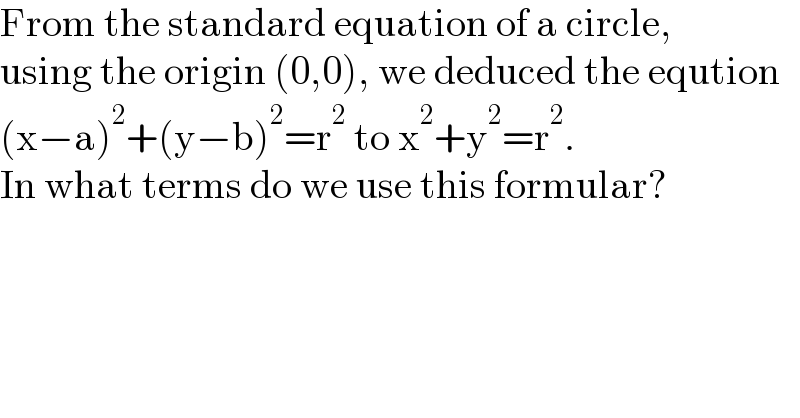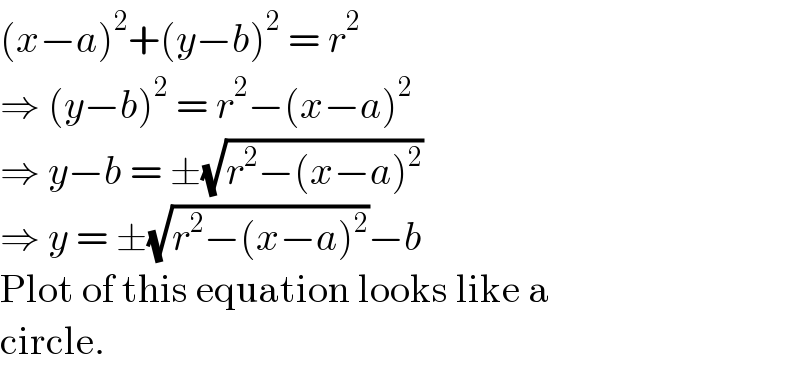
Question Number 166641 by pete last updated on 23/Feb/22

$$\mathrm{From}\:\mathrm{the}\:\mathrm{standard}\:\mathrm{equation}\:\mathrm{of}\:\mathrm{a}\:\mathrm{circle}, \\ $$$$\mathrm{using}\:\mathrm{the}\:\mathrm{origin}\:\left(\mathrm{0},\mathrm{0}\right),\:\mathrm{we}\:\mathrm{deduced}\:\mathrm{the}\:\mathrm{eqution} \\ $$$$\left(\mathrm{x}−\mathrm{a}\right)^{\mathrm{2}} +\left(\mathrm{y}−\mathrm{b}\right)^{\mathrm{2}} =\mathrm{r}^{\mathrm{2}} \:\mathrm{to}\:\mathrm{x}^{\mathrm{2}} +\mathrm{y}^{\mathrm{2}} =\mathrm{r}^{\mathrm{2}} . \\ $$$$\mathrm{In}\:\mathrm{what}\:\mathrm{terms}\:\mathrm{do}\:\mathrm{we}\:\mathrm{use}\:\mathrm{this}\:\mathrm{formular}? \\ $$
Commented by MJS_new last updated on 24/Feb/22

$$\mathrm{well},\:\mathrm{we}\:\mathrm{use}\:\mathrm{this}\:\mathrm{formula}\:\mathrm{every}\:\mathrm{time}\:\mathrm{we}\:\mathrm{have} \\ $$$$\mathrm{a}\:\mathrm{circle}\:\mathrm{with}\:\mathrm{center}\:\left(\mathrm{0}\mid\mathrm{0}\right)\:\mathrm{and}\:\mathrm{radius}\:{r}... \\ $$$$\mathrm{the}\:\mathrm{question}\:\mathrm{seems}\:\mathrm{strange}\:\mathrm{to}\:\mathrm{me}. \\ $$
Answered by alephzero last updated on 24/Feb/22

$$\left({x}−{a}\right)^{\mathrm{2}} +\left({y}−{b}\right)^{\mathrm{2}} \:=\:{r}^{\mathrm{2}} \\ $$$$\Rightarrow\:\left({y}−{b}\right)^{\mathrm{2}} \:=\:{r}^{\mathrm{2}} −\left({x}−{a}\right)^{\mathrm{2}} \\ $$$$\Rightarrow\:{y}−{b}\:=\:\pm\sqrt{{r}^{\mathrm{2}} −\left({x}−{a}\right)^{\mathrm{2}} } \\ $$$$\Rightarrow\:{y}\:=\:\pm\sqrt{{r}^{\mathrm{2}} −\left({x}−{a}\right)^{\mathrm{2}} }−{b} \\ $$$$\mathrm{Plot}\:\mathrm{of}\:\mathrm{this}\:\mathrm{equation}\:\mathrm{looks}\:\mathrm{like}\:\mathrm{a} \\ $$$$\mathrm{circle}. \\ $$
Commented by mr W last updated on 24/Feb/22

$${for}\:{me}\:\left({x}−{a}\right)^{\mathrm{2}} +\left({y}−{b}\right)^{\mathrm{2}} \:=\:{r}^{\mathrm{2}} \:{looks} \\ $$$${more}\:{like}\:{a}\:{circle}\:{than} \\ $$$${y}\:=\:\pm\sqrt{{r}^{\mathrm{2}} −\left({x}−{a}\right)^{\mathrm{2}} }−{b}. \\ $$
Commented by pete last updated on 24/Feb/22

$$\mathrm{Thanks}\:\mathrm{Sir} \\ $$
